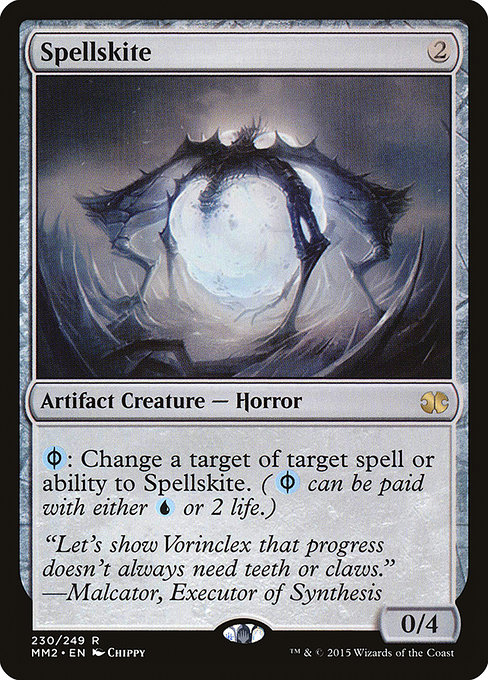Are you a Quiet Speculation member?
If not, now is a perfect time to join up! Our powerful tools, breaking-news analysis, and exclusive Discord channel will make sure you stay up to date and ahead of the curve.
Modern is a complex format, and nowhere is this complexity seen more than in its sideboards. The format has a very deep cardpool of quality cards to draw from, and the great number of possible sideboard cards make honing in on the optimal fifteen difficult. The format presents a huge variety of archetypes to be prepared for, so it is impossible to bring in cards dedicated to every possible matchup. There is an art and science behind crafting effective Modern sideboards, and I will attempt to explain the thought processes behind some familiar sideboards in the Modern format.
I started out writing this week intending on comparing and contrasting sideboard strategies for each archetype in the format, but I quickly saw how in-depth the project is, and that it requires thorough explanation of each deck, its sideboard, and its contents. I am going to continue my trend of focusing on sideboards and provide a matchup sideboarding primer, but I am going to really focus in on the fifteen cards in the sideboard, and explain the thought process behind including each card, why the sideboard is constructed like it is, and how it is used.
Modern is a diverse format with over twenty decks commonly played, and the top ten most commonly played decks online don’t even make up 50% of the metagame share. Knowing the theory and strategy behind a sideboard is more important than a strict sideboarding guide, and by the end of this article I will have covered each card in the sideboard and when and why to bring in each card. I’ll also show how I’d board against some of the most popular decks in Modern.
Green Urzatron has long been a staple of the format, and it’s been seeing a resurgence in success on Magic Online. It’s a great example for teaching lessons about Modern sideboards, and it’s the deck I’m focusing on today.
Green Urzatron
Urzatron is essentially a combo deck. It relies on artifact cogs to draw through the deck and assemble a combination of lands that generates big mana, and it uses the mana to cast huge spells. Like any combo deck, it's liable to be broken up. In Modern, many aspects of the strategy can be exploited, whether it be the artifacts, the lands, or the huge spells. Because the Plan A of Urzatron will overpower nearly every deck, Urzatron’s sideboard is focused on preventing and answering the disruptive and restrictive elements it is likely to face throughout a Modern tournament.
Few opponents have access to much maindeck land destruction, but Urzatron decks frequently come up against hate cards in sideboarded games. Tectonic Edge is the most common maindeck and sideboarded land destruction card, and cards like Molten Rain, Fulminator Mage, and Avalanche Riders are commonly seen from the sideboard.
A Crucible of Worlds in this sideboard is a great catch-all solution to generic land destruction cards.
One of the most common and powerful hate card Urzatron comes up against is Blood Moon, and it’s the sort of card that requires answering because it prevents Urzatron from ever generating the massive amounts of mana it needs to cast its most powerful spells.
The artifact cogs of Urzatron are quite susceptible to Stony Silence. Turning these artifacts off will render Urzatron unable to filter through its deck and find the action it requires. This card is one of the best sideboard hate options in the format against Affinity, which is a popular deck, so Urzatron is hit in the crossfire. Answering Stony Silence is quite important.
Nature's Claim is a very efficient answer to enchantment hate cards, and it generates tempo advantage by costing one mana to their two or three. The enchantment hate cards have the nature of global prison effects. They are quite restrictive when in play, but once removed they create no memory of their impact, as opposed to something like Sowing Salt, so they are quite susceptible to removal like Nature's Claim, so their removal allows Urzatron to operate freely
Nature's Claim also has the benefit of being effective sideboard hate against many of the other decks in the format, including the Big Three of Affinity, Twin, and Pod. It’s a functional Oxidize against Affinity, and it gives Urzatron an instant solution to their most threatening card, Cranial Plating. It’s also a pinpoint answer to Splinter Twin and Birthing Pod.
Nature's Claim is also broadly effective against the format. It kills Phyrexian Unlife and artifact mana from the Ad Nauseam combo deck, and it’s an answer to any enchantment from the GW Auras deck. It removes Bitterblossom and equipment like Sword of Feast and Famine.
In a pinch Nature's Claim can be cast on Chromatic Star or other cogs to gain 4 life, so it fills the role of lifegain against burn!
Once Urzatron has completed its gameplan of assembling Urzatron, it seeks to leverage the mana into board advantage. The way to accomplish this is with powerful spells, and it turns to enormous artifacts, typically Wurmcoil Engine and Karn Liberated. This deck also uses Wall of Dust as a board sweeper, and Sundering Titan to crush opponents playing many shocklands.
All of these spells are expensive, and as such they are quite vulnerable to counterspells. Commonly played cards like Goremand and Cryptic Command are clean answers that generate massive tempo, and they generate the time opponents need to execute their own combos of gain enough board presence to bury Urzatron.
Defense Grid is an effective preemptive solution for counterspells, and its resolution will eliminate the tempo-generating effect of counterspells if not outright preventing them. Cavern of Souls is another very effective solution to counterspells, which are prevalent enough to warrant playing this sideboard card in the maindeck. Another form of counterplay to countermagic is the maindeck Emrakul, the Aeons Torn, against which counterspells do nothing.
Urzatron is susceptible to combo decks, which are capable of winning before Urzatron can generate enough offense to win. Urzatron is built to crush fair decks, and it relies on select cards including Karn Liberated and Mindslaver to beat combo opponents by destroying their hand, and are usually too slow to be effective against strong combo draws. Bringing in disruption against combo decks is an important part of Urzatron’s sideboarding strategy.
Mindslaver is an excellent option in a metagame full of combo and control decks, and it’s essentially a maindecked sideboard card. It’s great against any and all combo opponents, and while it is slow, activating nearly always converts to a game win. The deck and sideboard is designed to slow down combo opponents long enough that Urzatron can generate ten mana and use the legendary artifact.
One of the most flexible anti-combo cards in the format is Spellskite, which has the benefit of being a colorless spell to cast off of Urza’s land. It’s a great card against Splinter Twin combo, because it stops their namesake combo card, and it draws out their removal spells. Spellskite is highly effective hate against the creature-buff combo decks like GW Auras and Infect, and they will typically be forced to answer Spellskite or lose. Spellskite is also effective for soaking up damage against Burn, which essentially operates like a combo deck.
Torpor Orb is another cheap artifact with application against combo decks. It’s yet another answer to Splinter Twin combo, which is typically regarded as the worst matchup for the deck. It also stops their Snapcaster Mage, and Urzatron brings in Torpor Orb against any deck using the creature, including URW control. Scapeshift combo also uses Snapcaster Mage and often Primeval Titan, so Torpor Orb is good there too. Torpor Orb is also quite effective against Birthing Pod, where it stops their combo and many of their value creatures.
The best sideboard hate artifact of all is played in the maindeck, Relic of Progenitus. It’s critical for combating Storm combo’s Past in Flames and Pyromancer Ascension. It also stops the Melira, Sylvok Outcast combo out of Melira-Pod, and it turns off Tarmogoyf and Snapcaster Mage. It’s quite effective against the Living End deck.
Two Combust is definitive hate for the Splinter Twin combo that gets around their Ancient Grudge and counterspells. This is also an effective card against common Azorius colored hate creatures including Vendilion Clique, Aven Mindcensor, and Meddling Mage. It also kills Restoration Angel and Celestial Colonnade.
The final anti-combo card in the sideboard is Vandalblast. Against Urzatron Affintiy plays much like a combo decks, and it looks to spill its hand into play and win as fast as possible. It’s best draws are faster than Urzatron’s, and while Urzatron has plenty of counterlay including Oblivion Stone, it’s popular enough in the metagame to warrant playing a dedicate hate card, and as an essentially split-card, Vandalblast offers flexibility and raw power.
An additional copy of Wurmcoil Engine is a nod to fair decks. It comes in against creature decks, and it’s an important part of the plan against removal-laden decks like Jund and the Rock.
VISUAL SIDEBOARDING GUIDE
Splinter Twin
Your expensive spells are ineffective against counterspells, and furthermore they leave you vulnerable to losing to the combo. Cut the clunky cards and become a sleeker deck full of hate cards that seeks to stall the game long enough to resolve Emrakul, the Aeons Torn. Mindslaver is actually not very effective because they lack many ways to leave them devastated afterwards.
Against Tarmo-Twin, you do not need Nature's Claim, and I’ve leave in a Wurmcoil Engine and an Oblivion Stone.
Sideboarding for the worst matchup is extreme, and I’d like to hear how others approach it.
Birthing Pod
This is one of the best matchups, and Nature's Claim shuts down Birthing Pod. Mindslaver can be effective, but the other cards tend to be more useful.
Affinity
Against Affinity, sideboarding is easy, and simply cut all of the cards that have no impact against them for all of the artifact removal in the sideboard.
UWR Control
Sideboarding for this matchup employs all of the principles I’ve discussed throughout the article! The best piece of advice here is to stay flexible and adapt to what the opponent plays.
Rock
With any questions or comments, turn to the comments and I may have an answer!
-Adam





























